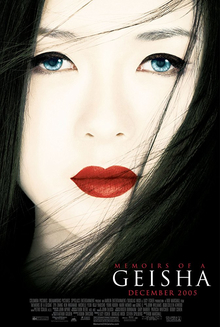
Back مذكرات فتاة الغيشا (فيلم) Arabic مموارز اوف اه جايشا ARZ Geyşanın memuarları (film) Azerbaijani بیر قئیشانین خاطیرهلری (فیلم) AZB Мемоарите на една гейша (филм) Bulgarian Memòries d'una geisha (pel·lícula) Catalan Gejša (film) Czech Die Geisha (Film) German Αναμνήσεις μιας γκέισας Greek Memoirs of a Geisha (filmo) Esperanto
| Memoirs of a Geisha | |
|---|---|
 Theatrical release poster | |
| Directed by | Rob Marshall |
| Screenplay by | Robin Swicord |
| Based on | Memoirs of a Geisha by Arthur Golden |
| Produced by | |
| Starring | |
| Cinematography | Dion Beebe |
| Edited by | Pietro Scalia |
| Music by | John Williams |
Production companies | |
| Distributed by | Sony Pictures Releasing |
Release dates |
|
Running time | 145 minutes[1] |
| Country | United States |
| Languages |
|
| Budget | $85 million |
| Box office | $162.2 million |
Memoirs of a Geisha is a 2005 American epic period drama film directed by Rob Marshall and adapted by Robin Swicord from the 1997 novel of the same name by Arthur Golden.[2][3] It tells the story of a young Japanese girl, Chiyo Sakamoto, who is sold by her impoverished family to a geisha house (okiya) to support them by training as and eventually becoming a geisha under the pseudonym "Sayuri Nitta." The film centers around the sacrifices and hardship faced by pre-World War II geisha, and the challenges posed by the war and a modernizing world to geisha society. It stars Zhang Ziyi in the lead role, with Ken Watanabe, Gong Li, Michelle Yeoh, Youki Kudoh, Suzuka Ohgo, and Samantha Futerman.
The film was produced by Steven Spielberg (through production companies Amblin Entertainment and DreamWorks Pictures) and Douglas Wick (through Red Wagon Entertainment). Production was split between southern and northern California and a number of locations in Kyoto, including the Kiyomizu temple and the Fushimi Inari shrine. It was released as a limited release in the United States on December 9, 2005 and a wide release on December 23, 2005, by Columbia Pictures and DreamWorks Pictures, with the latter receiving studio credit only.
The film garnered polarized reviews from critics worldwide and was moderately successful at the box office. It was also nominated for and won numerous awards, including nominations for six Academy Awards, and eventually won three: Best Cinematography, Best Art Direction and Best Costume Design. The acting, visuals, sets, costumes, and the musical score (composed by Spielberg's long-time collaborator John Williams) were praised, but the film was criticized for casting some non-Japanese actresses as Japanese women and for its style over substance approach. The Japanese release of the film was titled Sayuri, the titular character's geisha name.
- ^ "Memoirs of a Geisha (12A)". British Board of Film Classification. November 30, 2005. Retrieved November 4, 2016.
- ^ "Memoirs of a Geisha (2005)". tcm.com. Turner Classic Movies. Archived from the original on June 16, 2018. Retrieved June 6, 2020.
- ^ Golden, Arthur (1997). Memoirs of a Geisha (1st ed.). New York: Knopf. ISBN 978-0375400117.
© MMXXIII Rich X Search. We shall prevail. All rights reserved. Rich X Search